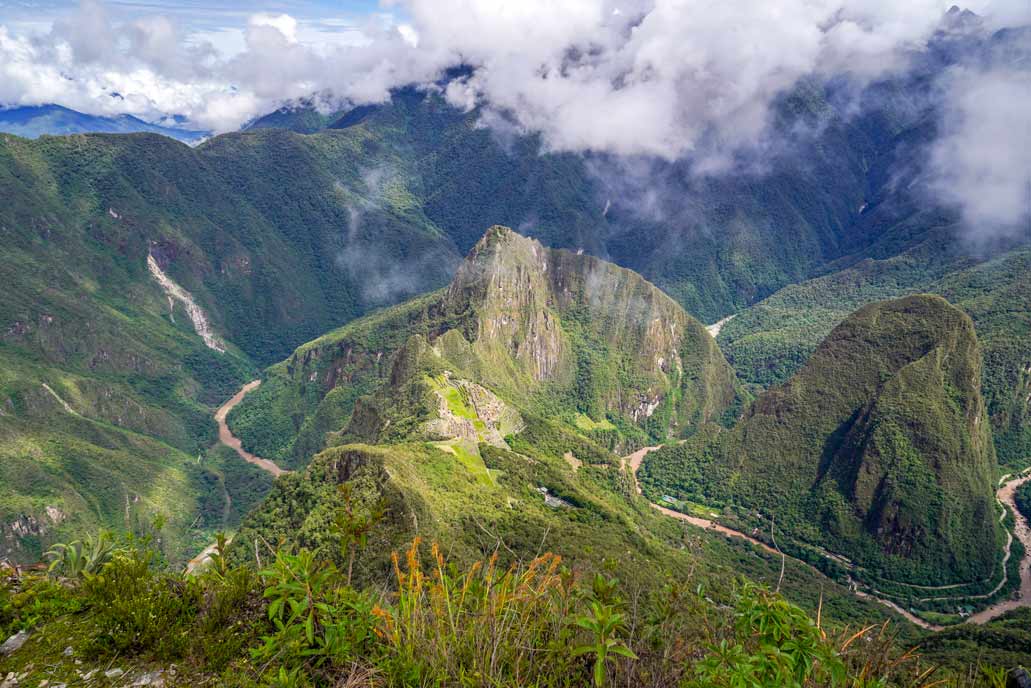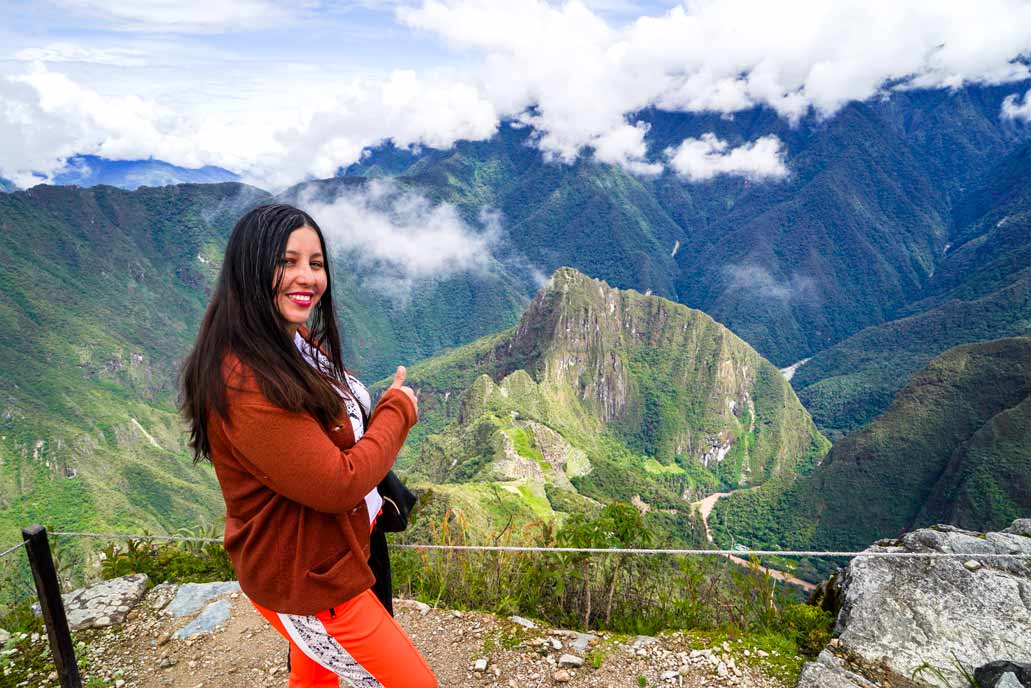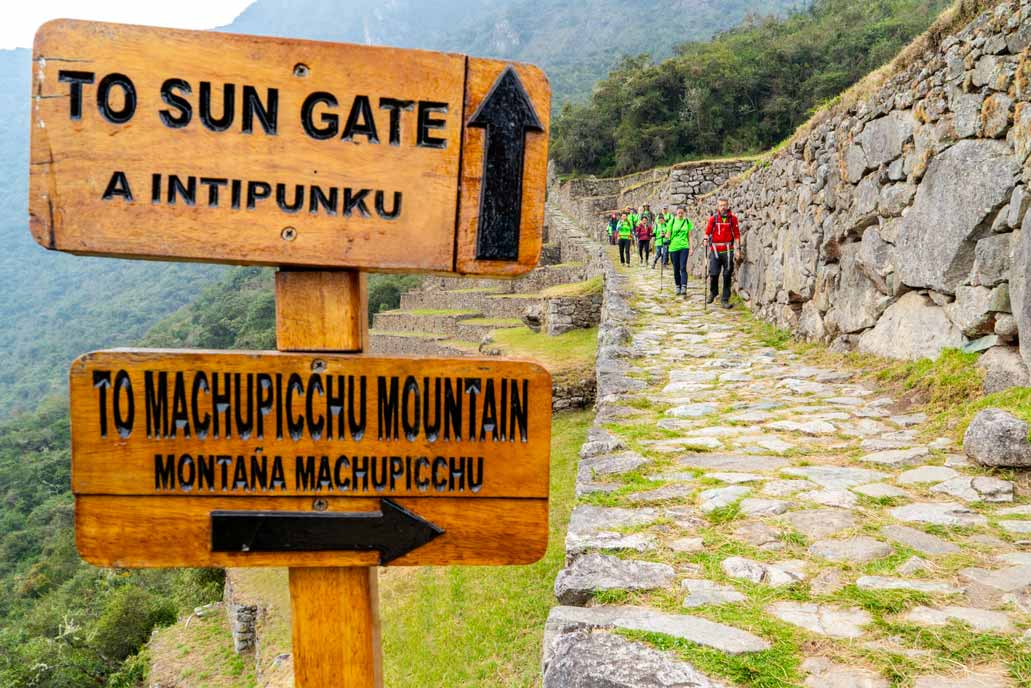All about Machu Picchu Mountain: Routes, Tickets, and Tips
Machu Picchu Mountain offers one of the most impressive hikes within the historic sanctuary. You can admire the Inca citadel from above, as well as unique natural landscapes. In this blog, you’ll find detailed information on access, the difficulty of the hike, estimated time, what to bring to Cusco if you plan to hike this trail, and key recommendations for planning your trip safely.
Content
What is Machu Picchu Mountain?
What is Machu Picchu Mountain?
Machu Picchu Mountain is a mountain of great historical and cultural significance located in the Cordillera de los Antes region, within the Machu Picchu district, in the Urubamba province of Cusco. It stands at an altitude of 2,430 meters above sea level and is famous for its proximity to the Inca citadel of Machu Picchu, one of the seven wonders of the modern world.
The name “Machu Picchu” comes from Quechua, the indigenous language of the region. “Machu” means “old” or “ancient,” and “Picchu” translates as “mountain.” Thus, Machu Picchu can be interpreted as “Old Mountain,” a name that reflects its imposing presence and historical connection to the Inca civilization.
What is the history of Machu Picchu Mountain?
Machu Picchu Mountain was a rugged territory with lush vegetation, at the foot of which lived a few families dedicated to agriculture and hunting. During the expansion of the Inca territory under Emperor Pachacutec (1418–1471 AD), the territory was annexed to the nascent Tahuantinsuyu Empire. This Inca was the one who ordered the construction of the Inca citadel at the foot of the mountain around 1450.
The Incas built roads to reach the top of the mountain. From there, they could worship their gods (the sun, the mountains, the moon). But they also had a privileged view that allowed them to watch for any invaders or visitors approaching the citadel. The construction of terraces, roads, and enclosures would have continued if not for the war between the Spanish and the Incas. The inhabitants of Machu Picchu had to abandon their lives and work in 1536.
Machu Picchu was gradually abandoned. For over 300 years, it lay forgotten in time until 1911, when explorer Hiram Bingham announced its discovery worldwide. The local people told him that the high peak overlooking the mountain was called “Machu Picchu.” The explorer used that name to refer to the Inca city. Today, the mountain offers an alternative hiking route to the traditional route through the archaeological site.
How long does it take to climb Machu Picchu Mountain?
Climbing Machu Picchu Mountain takes approximately two hours. Note! This time is only a guideline, as it all depends on your pace: it could take a little longer or even less time. No one will force you to go quickly, so you can enjoy your visit at your own pace.
If you prefer to do it quickly, it’s important to take it easy. Although the route may seem short, it’s physically demanding, so rushing could leave you feeling exhausted before you reach the summit. If you don’t take the time to enjoy the hike, you could miss out on interesting aspects of the landscape that could be part of a more fulfilling experience.
Tickets and reservations
How to buy tickets to Machu Picchu Mountain?
Let’s keep it simple! The best way to purchase your ticket to Machu Picchu Mountain is through the official website tuboleto.cultura.pe or from our website iMachupicchu . Why? Because if you try to buy it in person, you’re very likely to find no availability, unless you arrive in Cusco about three months in advance, which isn’t common.
- Step 1: Have your ID (for Peruvian citizens and CAN countries) or passport ready, as the platform will ask for this information.
- Step 2: Fill out the form that appears. Choose the “Route 1-A: Machu Picchu Mountain Route” ticket, select the time, the number of travelers, and enter your personal information such as names and ID or passport numbers.
- Step 3: Once you’ve completed the form, you’ll need to confirm your reservation. Then, make your payment on the same page. If you don’t make your payment within 3 hours, your reservation will be automatically canceled.
- Step 4: After making the payment, you can download your ticket digitally and save it to your phone, or if you prefer, you can also print it.
Upon arrival at the Machu Picchu entrance gate, you must present your ticket along with your ID or passport. Both are required. If you don’t have your ticket, whether printed or digital, or your ID, you will not be allowed to enter the citadel.
Ticket price to Machu Picchu Mountain
| Ticket price to Machu Picchu Mountain | |||
|---|---|---|---|
| Foreign | CAN countries | Peruvian | |
| General | 200 soles | 112 soles | 112 soles |
| Undergraduate student | 125 soles | 80 soles | 80 soles |
| Minor (3 – 17 years old) | 118 soles | 80 soles | 80 soles |
How far in advance should I buy the ticket?
Take note! You must purchase your ticket to Machu Picchu Mountain at least three months in advance. Why? Because the number of admissions is very limited, with only 400 tickets per day for both entry times (200 per time).
Can I find last-minute tickets? Very difficult. These tickets often sell out in minutes or hours due to high demand. Even if you see availability during the day, it’s likely there won’t be any more tickets left by the evening. Therefore, it’s important to book in advance. If you find it difficult to do so on your own, you can ask your travel agency or our travel agents for help .
Can I climb Machu Picchu Mountain without a guide?
It’s not mandatory to hike Machu Picchu with a tour guide. The vast majority of visitors prefer to go alone, without a guide.
However, visiting Machu Picchu with a tour guide is mandatory. Independent tourists can arrange a tour guide at the entrance to the archaeological site.
The average price for a shared tour guide service is $10 per person. Private tour prices range from $40 to $60 per group.
Tour information
How difficult is Machu Picchu Mountain?
Climbing Machu Picchu is considered a moderate to challenging hike. Why? The hike is steep (though not as steep as Huayna Picchu), with many steps that require physical effort. The trail is also approximately 2 km long.
Take note! If this is your plan, it’s a good idea to prepare yourself physically before your trip. You can do simple exercises like walking, running, or swimming to improve your endurance and breathing capacity. With this preparation, you’ll be ready to climb the mountain and overcome all its challenges.
How many steps are there on Machu Picchu Mountain?
Machu Picchu Mountain has approximately 1,600 steps distributed along the entire route. They are not narrow, so you can walk comfortably and safely. In some short sections, you won’t find any steps, so you can take advantage of this to rest and catch your breath before continuing.
Can you avoid the steps? No, the route to the summit is unique, and there are no alternate paths. But don’t worry! With good physical preparation, the steps won’t be a problem. You’ll see that even the most difficult things become possible when you set your mind to them.
Is it dangerous to climb Machu Picchu Mountain?
Climbing Machu Picchu Mountain is not dangerous. It’s an accessible route suitable for most travelers. Although you’ll be constantly climbing, the incline isn’t as steep or narrow as that of Huayna Picchu Mountain, so you’ll feel safer both on the way up and down. Here, vertigo won’t be a problem.
On the other hand, despite this being a safe route, it’s important to maintain a conscious attitude throughout the hike. There are some sections that may pose a certain risk, and the cobblestone path can cause slipping if you’re not careful, which could lead to injury.
Is there an age limit to go up?
There’s no upper age limit for climbing this mountain, so you can visit with your entire family or friends. Plus, the route is much safer than Huayna Picchu.
It’s important to note that a reasonable level of fitness is required to reach the summit. If you’re traveling with someone with a disability, it may be possible for them to complete the route, as long as they have sufficient mobility. Otherwise, it’s better to choose another route.
What to bring to Machu Picchu Mountain
What clothes should I wear to climb Machu Picchu Mountain?
To climb Machu Picchu, it’s important to wear lightweight clothing that allows you to move comfortably. Ideally, wear long-sleeved shirts, hiking pants or sweatpants, a waterproof jacket, and a cap or hat. As you can see, the list is short because you don’t need more. Bringing unnecessary clothing will only add weight to your backpack.
What if I wear other types of clothing? If you wear urban or formal clothing, you’ll be making a big mistake. These garments won’t allow you to move properly, which could cause falls. They can also be easily damaged by physical exertion, as they’re designed for quiet environments and not for demanding routes like this one.
What footwear is best for hiking?
It’s very important to take care of your feet during your hike. Therefore, it’s highly recommended to wear hiking shoes or sneakers, which have the necessary technology to help you walk comfortably, protecting your feet from perspiration and friction.
Can I wear formal or urban footwear?
Wearing formal or urban shoes could be one of the worst options. Why? Because these types of shoes aren’t designed to offer the necessary support while walking, which can cause slips, falls, and, most importantly, friction on your feet, which can lead to injuries. Plus, they’re likely to get damaged during your hike. You don’t want to return with a broken shoe or sneaker, do you?
Can I bring snacks or water?
Of course! During the hike, your body will tire, so it’s very important to bring some small snacks and water in reusable containers. This will give you the necessary momentum to continue and reach the summit of Machu Picchu Mountain.
Take note! Only snacks and non-alcoholic beverages are permitted during the trail. Food on plates or in other large containers is not permitted, nor is it permitted to bring alcoholic beverages into the park. If you do so, a park ranger may report your situation and you will be immediately removed from the citadel.
Best time to go up
What is the best season to climb Machu Picchu Mountain?
The best time to climb Machu Picchu Mountain is during the dry season, between April and September. During these months, the weather is more stable, allowing you to enjoy the trail without mud, fog, or rain that could hinder your journey.
What if I travel during the rainy season? If you plan to travel between October and March, you’ll just need to be more cautious on the trail. Bring appropriate rain gear, such as waterproof clothing and rain ponchos. With the right equipment, you’ll be ready to face the elements and reach the summit without complications.
Can you climb during the rainy season?
Of course! Something important you should know is that Machu Picchu Mountain is open year-round, regardless of whether it’s a Sunday or a holiday. If you plan to visit during the rainy season, be very careful when walking, as the stone steps can become slippery. It’s also essential to wear appropriate clothing and footwear for this climate.
Don’t forget! During this season, it’s also advisable to book your ticket to Machu Picchu Mountain in advance. Even though there are fewer visitors, it’s always better to be cautious.
What time is best to go up?
First, it is important to know that there are only two entry times: 6 am and 8 am. You must choose one and respect it, since you will not be allowed to enter outside of the selected time.
So, which is best? If you planned your trip during the dry season, both times are ideal. You’ll be able to enjoy privileged views of the citadel and the Huayna Picchu and Huchuy Picchu mountains. However, if you’re traveling during the rainy season, the most recommended time is 8 a.m. Why? Because fog is common during the early hours of the day, and by arriving a little later, you’re more likely to find clear skies and enjoy clearer views.
Tips and recommendations
How physically prepared should I be for Machu Picchu Mountain?
Don’t worry! To climb Machu Picchu, you only need to be in decent physical condition. You don’t need to have the physique of a professional athlete, which makes it quite accessible for most people.
Even so, it’s important to prepare beforehand. You can start with simple exercises like walking or jogging. Also, remember not to push yourself too hard during the hike, as this could leave you with muscle soreness the next day, especially if you have other activities planned after visiting the mountains.
How to acclimatize before hiking to Machu Picchu?
It’s easier than you think! Ideally, you should arrive at least one or two days before your hike so your body can adjust to the altitude and climate. Take note! During those first few days, take care of your diet by eating light foods, drinking plenty of water, and avoiding alcoholic beverages.
And what about altitude sickness? Also known as soroche, it can affect most travelers. If you follow these recommendations, you’ll help your body reduce the symptoms or, in the best case scenario, you could avoid it altogether. The key is prevention!




